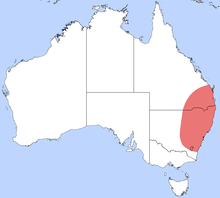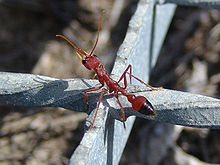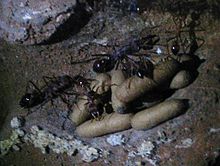Myrmecia gulosa
| Myrmecia gulosa | ||||||||||||
|---|---|---|---|---|---|---|---|---|---|---|---|---|

Myrmecia gulosa |
||||||||||||
| Systematics | ||||||||||||
|
||||||||||||
| Scientific name | ||||||||||||
| Myrmecia gulosa | ||||||||||||
| ( Fabricius , 1775) |
Myrmecia gulosa ( English "Red Bull Ant" or "Giant Bull Ant") is a species of ant from the subfamily of bulldog ants (Myrmeciinae), whichis native toeastern Australia . It is one of the largest species of ants in the world. Their poisonous sting can cause severe pain in humans for days.
features
As with all bulldog ants and knot ants (Myrmicinae), the petiolus ( petiolus ) of Myrmecia gulosa consists of two parts, the petiolus and postpetiolus. Within the two subfamilies, the species is characterized by its enormous size and the dark color of the rear half of the abdomen.
Workers
The workers are 14 to 26 millimeters long. They have a red-brown basic color, the last three segments of the abdomen ( gaster ) are black and the mandibles yellow-brown. Overall, the species is quite hairy, the yellowish hairs are of medium length on the body and shorter on the legs; they are missing from the antennas .
The head is slightly wider than it is long, the sides of the head are slightly convex. The compound eyes are large compared to other species of ants. The strong mandibles are a tenth longer than the head and curved inward at the front. There are twelve teeth on the inside of the mandibles, of which the third, fifth, seventh and ninth teeth are particularly long and sharp. The shaft (scapus) of the antennae protrudes almost a third of its length over the upper edge of the back of the head, the first and third antenna elements are the same length and one third shorter than the second antenna element. The mesosoma is twice as long as it is wide, with the mid-breast ( mesonotum ) being rounded. The abdomen is about the same length in profile as it is high, the rear limbs converge convexly, are slightly sloping downwards and end in a long and sharp spine.
queen
The queen becomes 27 to 29 millimeters long. Their color is similar to that of the workers, but they are more hairy and their overall shape is less filigree. The head is slightly wider than it is long, the mandibles are only about as long as the head and the antennae do not protrude as much. As with workers, the mesosoma is about twice as long as it is wide, but the abdomen is a third longer.
male
The males are 17 to 21 millimeters long. The color and hair are the same as those of the workers, but their overall shape is more delicate. The sides of the head are straight, the mandibles have only two small teeth at the end, and the second antennae is 6.5 times longer than the first. The mesosoma and abdomen are similar to those of the workers, but the sting is short and wide. The glassy wings have a pronounced yellowish color.
distribution
Myrmecia gulosa is common in the coastal regions in south Queensland and east from New South Wales to the Australian Capital Territory and the Murray-Darling Basin . The preferred habitats of the species are open forest areas and heathland. After bushfires , they are among the first species of ants to repopulate affected areas. The workers are diurnal and nocturnal.
Way of life
Compared to other species of ants, Myrmecia gulosa shows some archetypal and sometimes somewhat original behavior.
nest
The nests are underground and can contain over 2,000 individuals, around three quarters of which are workers. The species is monogynous and presumably monandric , which means that there is always only one queen in the nest and all workers are sisters.
In the vicinity of the nest, two to three guards can be observed at any time of the day or night to keep an eye out for possible intruders. The ants have very well developed eyesight with which they can recognize potential dangers up to a distance of two meters. The guards aggressively attack intruders of any size who get too close to the nest. In doing so, they literally jump on attackers in order to drive them away, which has earned them the nickname “Hoppy Joe”, and follow them well behind.
Food and hunting
The adults cannot eat solid food themselves and feed on nectar and other vegetable juices. The workers also hunt invertebrates such as bees and other ants, for example ross ants ( Camponotus ) or "Spiny Ants" (genus Polyrhachis ), which they feed to the brood. The diet is supplemented by shell-less trophic eggs from the workers, which are fed to the queen and the larvae and occasionally also eaten themselves.
The workers hunt at times individually and uncooperatively. Thanks to their good vision, they are able, for example, to go around their victims, jump on their backs and then kill them with a targeted stab. The social behavior of Myrmecia gulosa is less pronounced compared to more advanced ant species. There is no recruitment, and the ants cannot release any chemical signals ( pheromones ) for their nest mates and do not react to them.
Poison
The venom of Myrmecia gulosa is proteinaceous and very similar to that of bees and wasps. It contains histamine , hyaluronidase , a hemolytic factor and an activity comparable to that of kinins . The sting can cause severe pain in humans for several days. In some cases, allergic reactions ( anaphylactic shock ) can occur, which can also lead to death.
Life cycle
The queen only lays eggs for a brief period of a few weeks in spring. The larvae are legless after hatching and by the workers with animal food and trophic supplied eggs. They grow all summer and autumn and overwinter incompletely fully grown. In winter they do not eat any food, which is why the workers do not hunt for small animals. The following spring, growth will resume. At about the same time as the queen's next oviposition, the larvae are fully grown. They are covered with grains of sand by the workers, who use the larvae as a framework for pupation. During hatching, which takes place between the beginning of summer and mid-summer, the young animals are supported by workers who cut open the pupal shell with their mandibles.
particularities
In 1985, researchers at the University of New South Wales reported an ergatandromorphic specimen of Myrmecia gulosa that had characteristics of both a male ant and a worker. On the right side of the body the ergatander was male and also had wings, on the left side it was female. The animal was often attacked by its nest mates until it was finally removed from the colony by the researchers. Until then, no ergatandromorphism or gynandromorphism had been observed in bulldog ants .
Systematics

The first specimen of Myrmecia gulosa was collected between April and August 1770 on James Cook's first trip to the South Seas by the botanists Joseph Banks and Daniel Solander as the only insect next to a weevil ( Chrysolopus spectabilis ), a butterfly and two flies. Overall, Banks wrote very little about the insect world in Australia in his diaries, but the ants remained in his memory because of the many stings and their “vengeful disposition”. The type specimen is now part of the "Banks Collection" in the Natural History Museum in London and is said to be still in good condition.
After the return of the Endeavor Expedition to England in 1775, Myrmecia gulosa was described as one of the first insect species in Australia by the Danish entomologist Johann Christian Fabricius in his work Systema Entomologiae . He gave the ant species the name Formica gulosa ("voracious ant"). Fabricius had had the opportunity to view the expedition's insect collection on several visits to London in previous years. In 1804, Fabricius classified them in the genus Myrmecia , which is valid today , to which over 100 species are now assigned. Other names that are no longer valid are Eciton gulosa (Latreille, 1805) and Ponera gulosa (Illiger, 1807).
The Swiss ant and social researcher Auguste Forel described a subspecies Myrmecia gulosa obscurior in 1922 , which should differ from the nominate subspecies by a darker color and a narrow pronotum . However, there is no indication of the location within Australia. In 1951 the Australian entomologist John Clark doubted the existence of a subspecies of its own, today it is no longer scientifically recognized.
swell
Individual evidence
- ^ A b K. Ogata and M. Taylor: Ants of the genus Myrmecia : a preliminary review and key to the named species (Hymenoptera: Formicidae: Myrmeciinae) . In: Journal of Natural History . Volume 25, 1991, pp. 1623–1673 ( agr.kyushu-u.ac.jp [PDF; 3.6 MB ]).
- ^ Myrmecia gulosa (Fabricius, 1775). CSIRO Ants Down Under, 2009, accessed May 13, 2009 .
- ↑ a b c d e Clark, p. 49
- ^ Alan York: Long-term effects of fuel reduction burning on invertebrates in a dry sclerophyll forest. (No longer available online.) In: Biodiversity and Fire: The effects and effectiveness of fire management. Department of the Environment, Water, Heritage and the Arts , Australian Government, 1996, archived from the original on June 13, 2009 ; accessed on May 23, 2009 . Info: The archive link was inserted automatically and has not yet been checked. Please check the original and archive link according to the instructions and then remove this notice.
- ↑ Species Myrmecia gulosa (Fabricius, 1775). (No longer available online.) In: Australian Faunal Directory. Department of the Environment, Water, Heritage and the Arts , Australian Government, November 21, 2008, archived from the original March 8, 2016 ; accessed on May 23, 2009 . Info: The archive link was inserted automatically and has not yet been checked. Please check the original and archive link according to the instructions and then remove this notice.
- ↑ Caryl P. Haskins and Edna F. Haskins: Notes on the biology and Social Behavious of the Archaic Ponerine Ants of the genera Myrmecia and Promyrmecia . In: Annals of the Entomological Society of America . Volume 43, No. 4, 1950, pp. 461-491 .
- ↑ Vincent Dietemann, Christian Peeters and Bert Hölldobler: Role of the queen in regulating reproduction in the bulldog ant Myrmecia gulosa: control or signaling? In: Animal Behavior . Volume 69, No. 4, April 2005, p. 777-784 .
- ↑ a b c d e Mark W. Moffett: Lone Huntress. National Geographic , May 2007, accessed May 13, 2009 .
- ^ GWK Cavill, Phyllis L. Robertson and FB Whitfield: Venom and Venom Apparatus of the Bull Ant, Myrmecia gulosa (Fabr.) . In: Science Vol. 146., No. 3640 . October 2, 1964, p. 79-80 .
- ↑ Forbes McGain and Kenneth D. Angle: Ant sting mortality in Australia . In: Toxicon . Volume 40, Issue 8, 2002, pp. 1095-1100 .
- ↑ Robert W. Taylor: Bloody funny wasps! Speculations on the Evolution of Eusociality in Ants . In: RR Snelling, BL Fisher and PS Ward (eds.): Advances in ant systematics (Hymenoptera: Formicidae) . Memoirs of the American Entomological Institute, 80, 2007, pp. 580-609 ( antbase.org [PDF]).
- ^ MWJ Crosland, H. Crozier and E. Jefferson: Aspects of the biology of the primitive ant genus Myrmecia F. (Hymenoptera: Formicidae) . In: Journal of the Australian Entomological Society . Volume 27, 1988, pp. 305-309 .
- ^ Douglas Waterhouse: Insects and Australia . In: Journal of the Australian Entomological Society . Volume 10, Issue 3, 1971, pp. 145-160 .
- ↑ The Society emblem. Australian Entomological Society, April 23, 2009, accessed May 23, 2009 .
- ^ Winfried PK Radford: The Fabrician types of the Australian and New Zealand Coleoptera in the Banks Collection at the British Museum (Natural History) . In: Records of the South Australian Museum . Volume 1, 1981, pp. 155-197 .
- ↑ Auguste Forel : Glanures myrmecologiques en 1922 . In: Revue Suisse de Zoologie . Volume 30, 1922, pp. 87-102 .
- ↑ Myrmecia gulosa var. Obscurior Forel. (No longer available online.) Hymenoptera Name Server, December 19, 2007, archived from the original on March 4, 2016 ; accessed on May 13, 2009 . Info: The archive link was inserted automatically and has not yet been checked. Please check the original and archive link according to the instructions and then remove this notice.
literature
- CSIRO , Division of Entomology: Insects of Australia . Melbourne University Press, 1991, ISBN 0-522-84638-6 .
- John Clark : The Formicidae of Australia. Vol. 1. Subfamily Myrmeciinae . CSIRO, Melbourne 1951.
Web links
- Species: Myrmecia gulosa. AntWeb, accessed May 15, 2009 .
- Mark W. Moffett: Lone Huntress. National Geographic , May 2007, accessed May 15, 2009 .
- Red Bull Ant - Myrmecia gulosa. Brisbane Insects and Spiders, September 26, 2006, accessed October 17, 2009 .
- Robert W. Taylor: Australian Myrmecology Gallery. Japanese Ant Image Database, November 14, 2002, accessed May 23, 2009 (images of larvae, pupae, workers, males and a queen of Myrmecia gulosa ).



